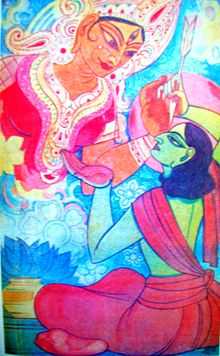Krittivasi Ramayan

Krittivasi Ramayan (Bengali: কৃত্তিবাসি রামায়ণ) or Krittibasi Ramayan or Sri Ram Panchali (Bengali: শ্রীরাম পাঁচালী), composed by 15th century Bengali poet Krittibas Ojha, is a translation of the Ramayana into Bengali, which represents the first translation of the Ramayana into any North Indian language other than Sanskrit. Written in the traditional Ramayan Panchali form of Middle Bengali Literature, the Krittivasi Ramayana is not just a rewording of the original Indian epic, but a vivid depiction of the society and culture of Bengal in the middle ages.
The text is also remembered for its exploration of the concept of Bhakti which would later contribute to the emergence of Vaishnavism in Gangetic Bengal and the surrounding regions.
Manuscripts
The total number of manuscripts (puthis) containing the Krittivasi Ramayan text numbers approximately 2,221.[1] Most of these contain only fragments of the text.
Extant manuscripts are presently stored in universities such as the University of Calcutta, Visva-Bharati University, Rabindra Bharati University, Jadavpur University, University of Burdwan, North Bengal University, in West Bengal. There are also puntis preserved in Silchar Normal School Library, Assam, Dhaka University and Jahangirnagar University, Bangladesh, the British Museum and School of Oriental and African Studies in the United Kingdom, and Bibliothèque nationale de France in France.
Timeline of Krittivasi Ramayan
The original Krittivasi Ramayan is dated to the first half of the 15th century. In the next four centuries it underwent various changes at the hands of various puthi scribes. The current version of the epic was revised by Jaygopal Tarkalankar and was published in 1834. Later in the 20th century various editions were published based on the Jaygopal Tarkalankar version.
Bengal in Krittivasi Ramayan

Krittivasi Ramayana is not only a translation, but contains picturesque descriptions of Bengali social life and its values.
Influence of Krittivasi Ramayan
The epic of Krittivas has had a profound impact on the literature of Bengal and the surrounding regions. Tulsidas, the 16th century Hindi Ramayana translator, was deeply moved by the theme of Bhakti just as Krittivas was. The story of Rama as depicted by Krittivas Ojha inspired many latter-day poets, including Michael Madhusudan Dutt and Rabindranath Tagore.
Notes
- ↑ p.82. Paschimbanga, Gazette of the Information and Cultural Affairs Department, Government of West Bengal, Krittibas Memorial Issue, February 2006
External links
Translation in English
- Ramayana, Shudha Mazumdar (translator), foreword by Dr. S. Radhakrishnan, Orient Longman, New Delhi 1958